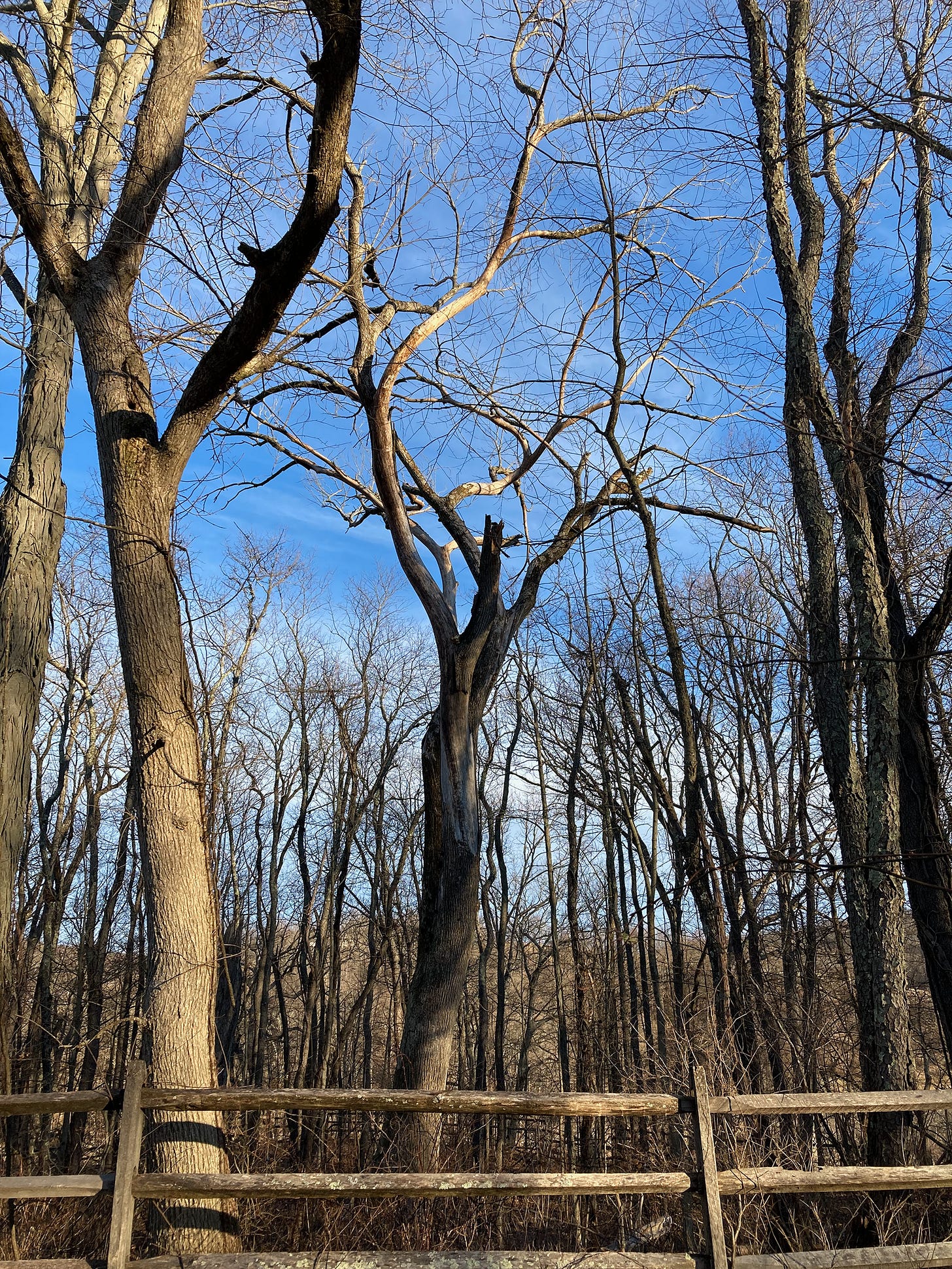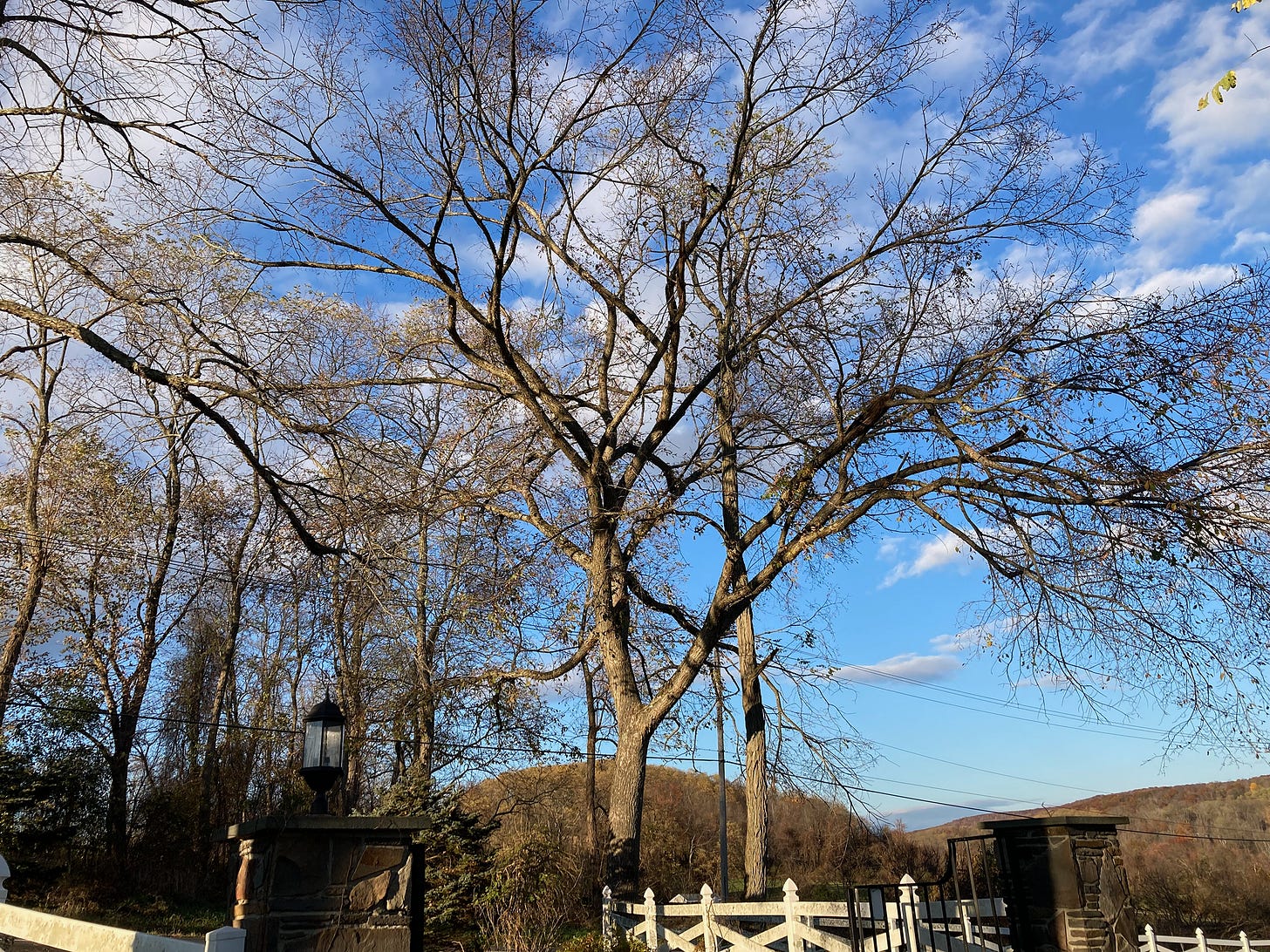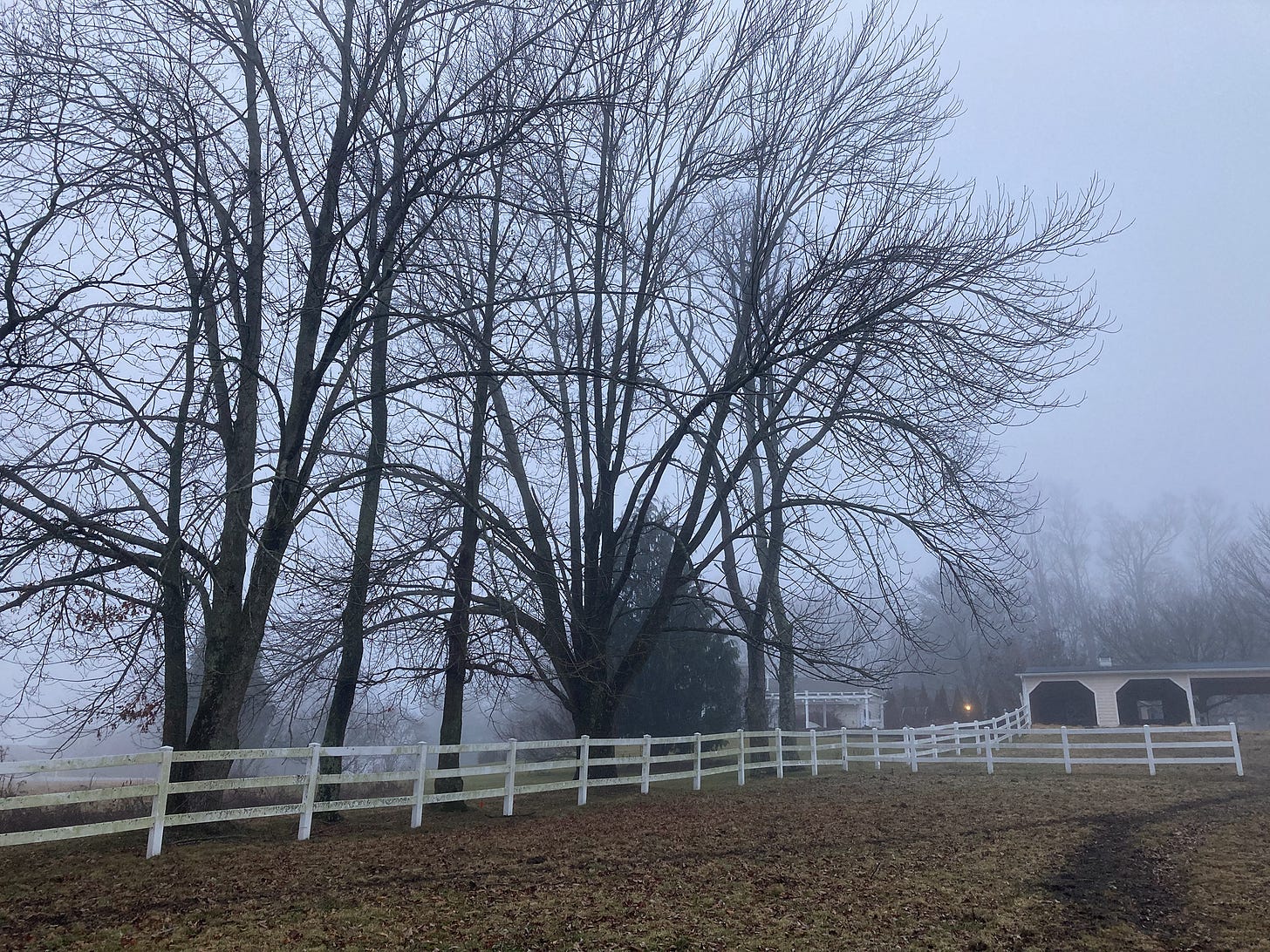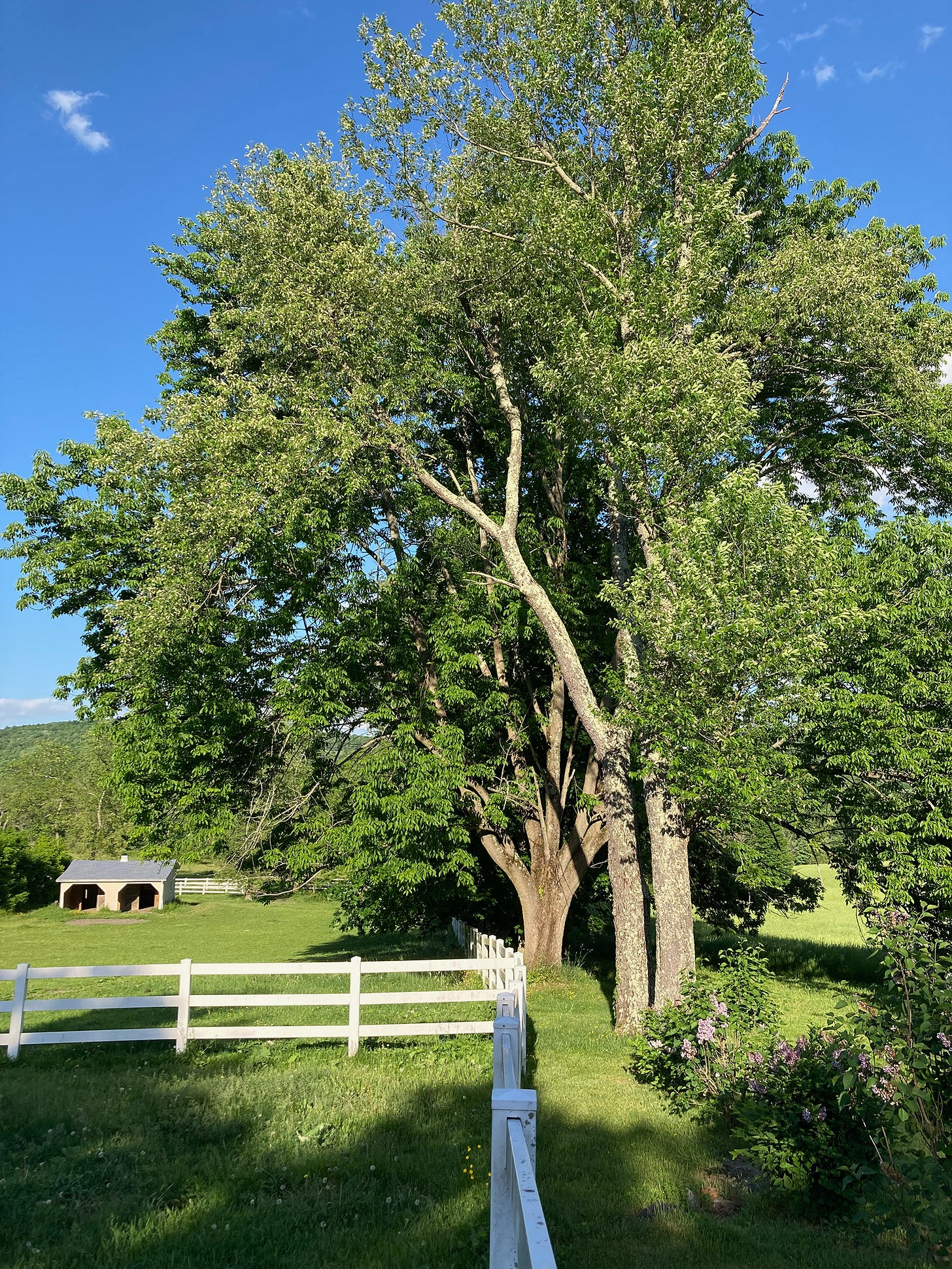Spring is when I take inventory of all the plants and trees after the winter in the course of doing cleanup around the farm. In particular, I have to collect many loads of fallen branches around the lawns and pastures before the mowing can begin. This is probably one of my least favorite jobs around the farm, and when I’m smart, I can time the project to coincide with the cleanup of downed trees so all the branches and limbs can go in the chipper. But this year I was not so lucky, and the entire task fell to me to do by hand. After a summer of drought, followed by a season of gypsy moth depredations, followed by a year of above-average rainfall and winter wind storms, many of the plants, and especially the trees, suffered and there were a lot of limbs to collect.
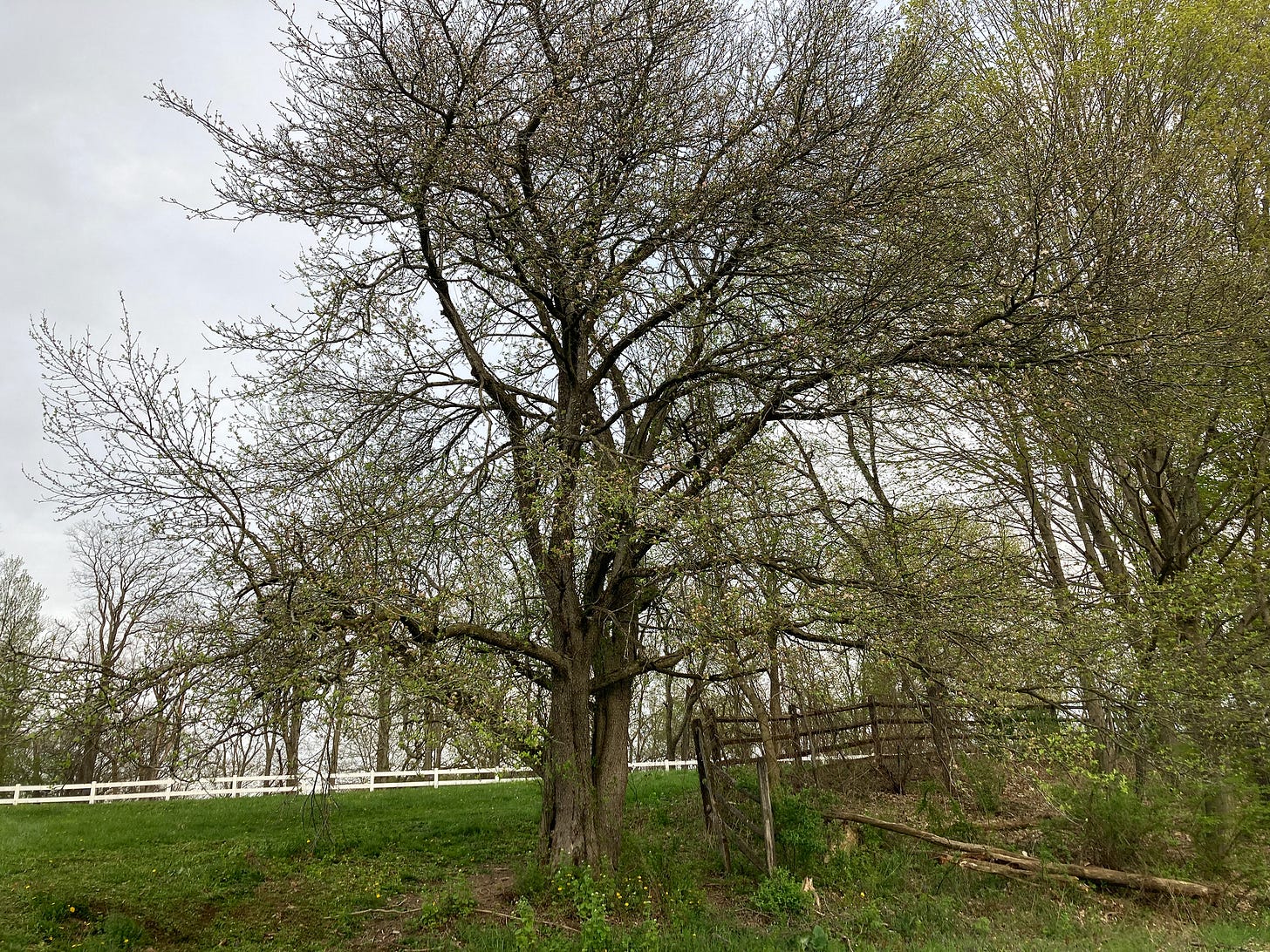
It has been a rough few years for our trees, perhaps none more so than the ash and elm.
As many may be aware, these species are currently threatened, at least here in the Northeastern United States.
The Emerald Ash borer, an invasive species originating in East Asia that probably arrived in shipping crates with the opening of commerce in the 1980s–1990s, is currently driving the ash to extinction across the West and will most likely eradicate it unless some unforeseen intervention is developed. For existing trees, there are treatments that allow the trees to defend themselves against the invaders. Expensive applications undertaken every two years can help preserve healthy specimens. But trees in the wild or those already damaged beyond repair are lost, and new saplings are unlikely to take hold, so the prospect of a new generation of ash trees is grim.
Parts of Europe seem to be suffering a similar extinction event involving ash trees from an invasive fungus, Hymenoscyphus fraxineus, which researchers record causing mortality rates of 60–90 percent for affected ash trees in addition to an onslaught of ash borers in some regions.
As for the elm, Dutch Elm disease (DED) (named after the researchers who identified it, though it also originates with a non-native invasive species) is highly contagious and destructive. Once the beetles that transmit the fungus enter an area, infection is almost inevitable. Treatments are available, but, as with the ash treatments, they are limited to specimen trees. On a more positive note, DED-resistant cultivars are becoming available and seem to be successful so far. Barring any mutations in DED, they will hopefully remain viable for the future, though only time will tell. But like the ash, wild elm trees will likely soon become extinct.
If you sense a trend here, you are probably picking up on the same worry I am—that we are soon to live in a world where, barring cockroaches, rats, and a handful of hardy weeds, the only species left on the earth will be domesticated. I include humanity in that statement as the preeminent example. We seem determined to recreate the world in our highly cultivated image and are succeeding at a rapid pace, whether by accident or intention. But nature shouldn't be neatly confined and tamed in segregated areas for our convenience, and evolution shouldn’t take place in a laboratory. Something has gone amiss when every aspect of our world must be engineered to survive.
The larger Darwinian part of me believes we should embrace the fact that nature balances itself with a cruel but necessary ferocity and some species are simply destined to eventually fail when their habits or genetics leave them unable to defend against the onslaught of disease, predation, or competition. But another part of me feels responsible for defending the creatures whose demise is brought about directly or indirectly by human ignorance and excess. Fair’s fair. When shipping crates ferrying cheap goods from the other side of the world also bring blights that wipe out entire species, it feels like that one’s on us. It’s as if Icarus and Pandora had a child and put it in charge of global commerce. We live with the results of that foolishness every day.
Our Ash and Elm
I began noticing the damage to the ash and elm trees around the farm years ago and have felt powerless to stop it. There was a majestic elm in the forest near the trails at the edge of the back field that had a kind of Lord of the Rings quality to it. Its limbs sort of swirl upward in an elegant, mystical spiral, but in a powerful way that only massive trees can manage. The guys who used to do my tree work fell in such love with the tree that they cleared a bunch of “junk trees” from around it to open it up to the light, even though it was in the middle of the forest where no one ever saw it. They did this almost out of reverence, and it was strange for me to realize that men who cut down trees for a living could have such an appreciation for them. Then DED got hold of it, and it withered away. They brought me back to the woods to show me the tree when it had died, and I could see how sad and troubled they were. Soon it was just a skeleton. Then golden oyster mushrooms grew on its decayed form, and it collapsed on itself into a heap on the forest floor. All within the span of a couple years. Other elms on the farm would soon follow, they said.
The death of the ash trees has been slower but just as tragic. The farm has numerous ash trees, including a young stand at the bottom of one of the pastures and several hundred-plus-year-old trees along a half-mile of roadway. But the glory of all the ash trees on the farm is this specimen, whose age I can’t quite estimate but is no doubt ancient. The local tree service I hired to treat it has told me that it may be the oldest remaining ash in the county. That makes me all the more anxious about it.
Warden Trees
Apart from the responsibility I feel for preserving the ancient tree and the ashes in general, I am reminded of an ancient belief in something called a warden tree:
A very old tree (often a linden, ash or elm) growing on the farm lot could be dubbed a "warden tree" (Swedish: vårdträd), or (Norwegian: tuntre) and was believed to defend it from bad luck. Breaking a leaf or twig from the warden tree was considered a serious offence. The respect for the tree was so great that the family housing it could adopt a surname related to it, such as Linnæus, Lindelius and Almén. It was often believed that the wights (Swedish vättar) of the yard lived under the roots of the warden tree, and to them, one sacrificed treats to be freed from disease or bad luck. The Guardian trees were said to have been taken from sacred groves as saplings by pre-Christian Germanic peoples, though today can be planted from anywhere.
A tree this old has preceded all the people and nearly all the structures on and around the farm today. Did it exist yet in 1750 when the farmhouse—first a tavern—was moved from its original location to the corner where it now stands? Was it just a sapling when the one-room schoolhouse down the lane was built? Did anyone ever come to sit in its shade? Did the old farm’s horses and cattle rest beneath it as my horses now do? It has witnessed more history than anyone alive today will ever know. That it can't voice that history doesn’t necessarily negate its importance in the greater scheme of things. Not for me. It’s connected to the farm more deeply than most of us will ever be. It is invested in the land in a way no human could ever be. Its roots run beneath our feet when we walk the surrounding fields. Under the right conditions, it might live another two hundred years, but the chances of that seem grim.
Ask and Embla
The same tradition that believed in warden trees also believed that humanity was born from none other than the ash and elm. The Adam and Eve of this ancient tradition were known as Ask and Embla.
According to the eddic poem VÖLUSPÁ, Embla was the name of the first woman, created alongside her male counterpart, ASK, from two tree trunks, which the god ODIN and two companions, HŒNIR and LODUR, found by the shore of the circling sea. The thirteenth-century Icelander SNORRI STURLUSON repeats the tale but names Odin’s companions his brothers, VILI and VÉ. Unlike Ask, which seems clearly to derive from the word for an “ash tree”, the etymology of Embla is obscure. Some see it as a distant form of the word for “elm”, while others have pointed out a similarity with the Greek word for “vine” (άμπελος), a soft and inflammable wood, often used as a base into which a pointed stick of some harder wood such as ash is rubbed to produce fire. The psycho-sexual appeal of the latter interpretation will be clear.1
In Norse myth, the gods fashioned the first humans from the storm-tossed driftwood of a primeval forest washed up on an ancient shore. Metaphorically speaking, that just feels right. There has been much pearl-clutching of late about the supposed “repaganization” of the West. Though I do not consider myself a pagan (I’m not anything), the pagan traditions’ deep sense of reverence for and interconnection with the natural world makes me appreciate them more than the cold, managerial stance of the Judeo-Christian traditions to which the natural world is simply something God granted humanity dominion over to ultimately despoil. We’ve seen how that worked out.
VIII. Then said Gangleri: "What was done then by Borr's sons, if thou believe that they be gods?" Hárr replied: "In this matter there is no little to be said. They took Ymir and bore him into the middle of the Yawning Void, and made of him the earth: of his blood the sea and the waters; the land was made of his flesh, and the crags of his bones; gravel and stones they fashioned from his teeth and his grinders and from those bones that were broken." And Jafnhárr said: "Of the blood, which ran and welled forth freely out of his wounds, they made the sea, when they had formed and made firm the earth together, and laid the sea in a ring round. about her; and it may well seem a hard thing to most men to cross over it." Then said Thridi: "They took his skull also, and made of it the heaven, and set it up over the earth with four corners; and under each corner they set a dwarf: the names of these are East, West, North, and South. Then they took the glowing embers and sparks that burst forth and had been cast out of Múspellheim, and set them in the midst of the Yawning Void, in the heaven, both above and below, to illumine heaven and earth. They assigned places to all fires: to some in heaven, some wandered free under the heavens; nevertheless, to these also they gave a place, and shaped them courses. It is said in old "songs, that from these the days were reckoned, and the tale of years told, as is said in Völuspá:
The sun knew not | where she had housing;
The moon knew not | what Might he had;
The stars knew not | where stood their places.
Thus was it ere | the earth was fashioned."Then said Gangleri: These are great tidings which I now hear; that is a wondrous great piece of craftsmanship, and cunningly made. How was the earth contrived?" And Hárr answered: "She is ring-shaped without, and round about her without lieth the deep sea; and along the strand of that sea they gave lands to the races of giants for habitation. But on the inner earth they made a citadel round about the world against the hostility of the giants, and for their citadel they raised up the brows of Ymir the giant, and called that place Midgard. They took also his brain and cast it in the air, and made from it the clouds, as is here said:
Of Ymir's flesh | the earth was fashioned,
And of his sweat the sea;
Crags of his bones, | trees of his hair,
And of his skull the sky.
Then of his brows | the blithe gods made
Midgard for sons of men;
And of his brain | the bitter-mooded
Clouds were all created."[Compare the above cosmogony to the one discussed here and here.]
IX. Then said Gangleri: "Much indeed they had accomplished then, methinks, when earth and heaven were made, and the sun and the constellations of heaven were fixed, and division was made of days; now whence come the men that people the world?" And Hárr answered: 'When the sons of Borr were walking along the sea-strand, they found two trees, and took up the trees and shaped men of them: the first gave them spirit and life; the second, wit and feeling; the third, form, speech, hearing, and sight. They gave them clothing and names: the male was called Askr, and the female Embla, and of them was mankind begotten, which received a dwelling-place under Midgard.’ [emphasis added]2
While the fire drill interpretation above is appealing in its own way, construing the mother of humanity, Embla, as little more than a clinging vine upon her masculine counterpart is less so. I have an entire catalog of complaints about the Bible, but they begin early with things like Eve being cobbled together from spareribs, little more than an appendage of Adam—as James Joyce put it, a “cutletsized consort”—and an afterthought in creation generally. But the Norse myth makes it very clear that two trees—not a tree entangled in a vine—were found on that primeval beach, suggesting a sense of balance. Indeed, when one considers the qualities of the ash and elm, they are both imposing, sturdy trees in their own right. The ash has historically been used to haft weapons and tools such as spears and axes because of its combination of strength and flexibility. Elm, on the other hand, is a superior wood for outdoor building due to its size, strength, and resistance to rot. This woodworking site compares and contrasts the two kinds of wood, describing the characters of each. Ash, curiously, is described as delicate, gentle, sweet, and perishable, while elm is referred to as robust, tough, rich, and durable. Certainly, there are numerous softwoods to choose from, and the ancients could have chosen a more demure, willowy tree or vine to represent the female half of this equation. But they must have paired these impressive trees as the progenitors of mankind for a reason, and it’s interesting to consider why.
Whichever tradition we prefer, if we consider that some ancient people held these trees so sacred they believed they owed their existence to them, what does it say about us that our unrelenting and exponential expansion is bringing about their extinction? Is this Ragnarök? Maybe it’s just the normal course of nature, as it has forever been. But in the wake of a pandemic, it feels like more. When I walk the fence lines collecting fallen branches before the mowing begins, and see this, I can’t help but worry:

Why does it matter? Because entire ecosystems are tied up with these trees, of course. Other species rely on them for food and habitat. Deleting them from the planet will mean leaving a void in that ecosystem. Next door is a mature forest—over eighty years old—that a foreign company wants to clear-cut and uproot to build a forty-acre solar power plant with a shelf-life of twenty-five years. The forest provides habitat to three endangered species. They assure us this is what “green” progress looks like. Many local citizens are fighting this effort, but we likely don’t stand a chance against the powerful energy-industrial complex hungry for our rural lands, including woodlands. That they’re doing so funded by our tax dollars is just salt in the wound. It’s hard not to look around and see the destruction—both inadvertent and willful—as a warning.
But it’s something else as well. A tradition and a culture have also been constructed around the character and nature of these trees. It sounds almost naive to say such a thing in our high-tech world of 24–7 screens and AI. But there was a time when our ancestors revered nature and paid heed to the world they lived in. When they believed the cosmos itself was fashioned from a body not unlike their own, and they, in turn, were sprung from the land. Trees and the products they provided would have been among the most important resources available to early Europeans, and when we talk about the reverence philosophers like the early Druids had for trees, I think it is an echo of this early understanding of the unique properties and characteristics inherent in different species of trees for wood, sap, flowers, nuts, etc. Knowing which trees were appropriate for building, for boat-making, for weapons, for warmth, for carving, for cooking, for smoking, for food, for medicine. Intimate knowledge of the different trees and their properties and the ability to evaluate each were essential to survival, and many things essential to survival were elevated above the profane to the sacred.
After all, the Norse world tree Yggdrasil was also said to be an ash tree, now gradually going extinct in our world, consumed by insects and fungi. And the Liberty Tree, around which the American Revolution was organized, was an elm that would today be endangered not by the axes of vandals or foes but by an invisible yet devastating blight. As I’ve said before, I’m not religious, but I am a believer in myth-as-metaphor. And I wouldn’t blame anyone for reading something darkly prophetic in all this. The things we care about, the things that matter, are always under threat. The question is, what will we do, if anything, to preserve them?
Yggdrasil's ash | great evil suffers,
Far more than men do know;The hart bites its top, | its trunk is rotting,
And Nithhogg gnaws beneath.3
Andy Orchard, “Ask and Embla” in Dictionary of Norse Myth and Legend (New York: Sterling Publishing, 1997), 38.
Snorri Sturlson, “Gylfaginning” in The Prose Edda of Snorri Sturlson, trans. Arthur Gilchrist Brodeur, (New York: The American-Scandinavian Foundation, 1916), stanzas 8–9.
Compare with The Poetic Edda:
Then from the throng | did three come forth,
From the home of the gods, | the mighty and gracious;
Two without fate | on the land they found,
Ask and Embla, | empty of might.
Soul they had not, | sense they had not,
Heat nor motion, | nor goodly hue;
Soul gave Othin, | sense gave Hönir,
Heat gave Lothur | and goodly hue.
Henry Adams Bellows, trans. “Voluspo” in The Poetic Edda, (Princeton: Princeton University Press, 1936) stanzas 17–18.
Henry Adams Bellows, trans., “Grimnismol” in The Poetic Edda, 2 vols., (Princeton, NJ: Princeton University Press, 1936), stanza 35.





